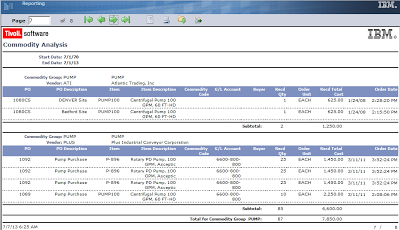Commodity codes are standard classification codes for products and services used to detail where money is spent within a company.
In Maximo commodity codes are used to define similar types of items, tools, or services. Commodity codes are also grouped together in commodity groups. A commodity group contains a grouping of individual commodity codes.
Commodity groups and codes can be created and managed selecting the Add/Modify Commodity Codes action in the one of following applications: Companies, Item Master, Purchase Orders, Service Items, Tools. This IBM TechNote describes how to manually enter commodity codes.
Once you have defined commodities you can associate them with company, contract, and item records. You can also associate commodities with individual purchase order or requisition lines for items, service items, or tools that do not have commodity codes assigned to them, including special order materials or services.
Classifying items, tools, services with commodity groups and commodity codes provides a way to analyze and optimize spending by product type. To support such spending review process, Maximo provides the Commodity Analysis report in the Item Master application.
The Commodity Analysis report shows a summary list of items received during a given time period grouped by commodity groups and vendors. The first part of the report shows the received cost by commodity groups presented as a bar chart.
The second part of the report shows data in a table format. For each commodity group, the cost summary for each vendor is computed and shown as subtotal.
This report is useful in identifying what commodities made up the bulk of purchase costs and thus, are critical for cost controls. For large organizations it can be used to compare price points from different vendors in order to restructure and optimize expenditures across sites and divisions.
There are several standards for commodities classifications like UNSPSC, HS, NIGP. Many clients define their own classifications codes and groups in Maximo.
The UNSPSC (United Nations Standard Products and Services Code) standard is well known and is translated into many languages. Codes can be downloaded for free in PDF format or purchased in Excel format. Is it also possible to search and browse codes with a simple search engine.
It may be also interesting to hear something from you.
What is your preferred commodity codes structure in Maximo?
Do you use standard codes or have you defined you own structure?



My 2 cents on this topic:
Many of my customers use for items both commodity code and classification. Commodity codes are useful for reports but classifications normalize the use of custom attributes. Usually commodity codes come from ERP (like SAP) so the decision of using a standard codification is taken from another LOB and not in MRO field.
Thanks Diego
Hi Brunu Commodity codes I define at PO application will not get copied to item master in maximo I want to know is there any reason for this ?
Hello Burno, Can a child commodity code become a parent for new commodity code? Meaning
Commodity Group (Parent is null)
Child 1 where Parent = Commodity Group.
Child2 where Parent = Child1.
Please reply
Santosh
Hello.
Maximo log file generates a message:
[25.06.15 10:23:51:051 GMT+03:00] 00000054 SystemOut O 25 РёСЋРЅ 2015 10:23:51:026 [ERROR] BMXAA6714E – Data for the next record in the mboset could not be retrieved for the SQL query: select * from commodities where commoditygroup=commodity for read only
com.ibm.db2.jcc.am.ro: "COMMODITYGROUP" is not valid in the context where it is used.. SQLCODE=-206, SQLSTATE=42703, DRIVER=3.58.81
What does that mean? Where to find the problem?